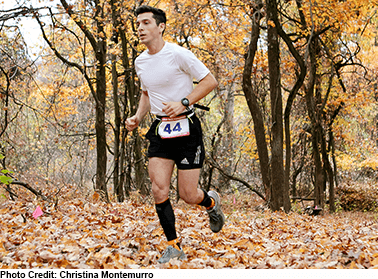Greg’s Story: How the Hip Preservation Program Kept a 27-Year-Old Marathoner Moving
Greg Blobner was a high school football player when he first met UPMC orthopaedic surgeon Craig Mauro, MD. It was 2013, and Greg had torn the anterior cruciate ligament (ACL) in his right knee. Dr. Mauro fixed it — and then fixed Greg's left ACL four years later.
When Greg's left hip started hurting in August 2021, he knew exactly whom he wanted to see. He felt comfortable with Dr. Mauro, who also headed the Hip Preservation Program at UPMC Orthopaedic Care.
This program mostly focuses on athletes and active people with hip injuries. That definitely describes Greg, who is 27, runs marathons, and participates in triathlons.
"I started running track in seventh grade, and I've been a runner ever since," he says.
The problem was that running seemed to cause some pain. Not muscle pain or soreness. But a different kind of pain at the front of his hip, deep into the groin.
"The best way I can describe it is that it felt like having a headache in my hip," says Greg, who works in software development for hospitals.
Dr. Mauro specializes in diagnosing athletes like Greg. After looking at Greg's imaging, he knew right away what was wrong, and the answer surprised Greg.
A Hip Impingement Diagnosis
Dr. Mauro told Greg that he had femoroacetabular impingement (FAI). Another term for FAI is hip impingement, and it means the ball and socket of the hip aren't acting as they should.
"He explained that the end of my femur should be a perfectly round ball shape," Greg says. That shape is what allows the bone to fit into the socket. Greg could see on his imaging that his had an almost square shape.
This misalignment of the socket can damage the cartilage (the labrum) surrounding the socket (the acetabulum). "Basically, with every stride, the bone was grinding against the cartilage," Greg says.
Dr. Mauro recommended that Greg undergo physical therapy. Sometimes, physical therapy can improve FAI. "I appreciated that he didn't immediately jump to surgery," Greg says.
Greg also appreciated that Dr. Mauro never told him to just stop running.
"Instead, he asked, 'How important is running to you?'" Greg says. "I told him that it's important for me to be able to function and live my life."
Dr. Mauro and team work with athletes and inherently understand that treatment should focus on return to activity.
"It always felt like Dr. Mauro was acting in my best interest," Greg says.
Greg followed through with the whole year of nonoperative care. He ran his first marathon in 2022, but the pain kept nagging.
FAI Surgery on Both Hips
When his pain persisted, Greg went back to Dr. Mauro. After taking more imaging, Dr. Mauro recommended a hip arthroscopy surgery.
This is a minimally invasive surgery in which the surgeon repairs the cartilage and shaves off the excess bone. It only requires small incisions because it uses a tiny camera and tiny surgical instruments.
Greg had the surgery in September 2022.
"It was far easier than ACL surgery," he says. The surgery was outpatient, with Greg arriving at UPMC St. Margaret around 6:30 a.m. and leaving around noon. "I had no pain, just some swelling."
Greg started physical therapy the day after surgery, working with Michaela Golden, PT, DPT, OCS. She got him moving again and assigned him a program. Michaela was just about to discharge Greg from PT when his right hip started to hurt.
The pain wasn't as bad as it had been on his left side. But Dr. Mauro had told Greg that he had FAI in his right hip as well. It was just a matter of how much worse it would get and when it would need fixing.
He decided to do it right then instead of waiting.
"The success of the left hip made me want to do the right," Greg says. "I figured, I'm young and I want to run for years to come."
Dr. Mauro agreed. In December 2022, Greg had the same hip arthroscopy procedure on his right hip. It wasn't nearly as damaged as the left hip, but Greg liked that he wouldn't have to worry about future surgery.
Back to Full Activity
Having the right hip done just as he was almost cleared for full activity on the left slowed Greg down just a bit. But he was certain he wanted to rehab the right hip and get back to running.
In March 2023, the care team cleared Greg for all activity. He ran the 5K at the Pittsburgh Marathon in May 2023 without problems.
"My right hip is 100%, and I have no pain," he says. "In my left hip, I feel some discomfort maybe one to two days a month, but I can resolve it with stretching and foam rolling."
Greg, who lives in the North Hills and often runs at North Park, plans to run the Cleveland Marathon in May 2024. He's also training for a triathlon in North Park in July and might do a Half Ironman in the fall.
He no longer feels limited by his hip pain, and he has no regrets about having the surgeries. It was hard to take time off to do it. That was his biggest obstacle because he's such an active person.
The only thing he might have changed is not waiting the whole year to have the surgery. But he also knows he might have second-guessed it if he hadn't waited.
Ultimately, there's no perfect equation for when it's time to have surgery. But Greg is very glad to have reached the other side of it, crossing finish lines again.
If you have hip pain and don't want it to keep you from doing what you love, read about the Hip Preservation Program or call 412-784-5770.



















